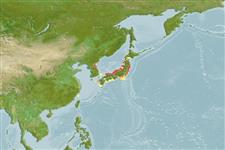Elasmobranchii (Haie und Rochen) (sharks and rays) >
Rajiformes (Skates and rays) >
Arhynchobatidae (Softnose skates)
Etymology: Bathyraja: Greek, bathys = deep + Latin, raja, -ae = a ray (Raja sp) (Ref. 45335); caeluronigricans: Named for the purplish black color of the dorsal side of the disk (Ref. 75535).
Issue
This species is a synonym of Bathyraja matsubarai (Ishiyama, 1952) after Last et al. (2016: Ref. 113540)
Environment: milieu / climate zone / depth range / distribution range
Ökologie
seewasser demersal; tiefenbereich 200 - 400 m (Ref. 58018). Temperate
Northwest Pacific: north of Tôhoku, Japan to the Sea of Okhotsk.
Size / Gewicht / Alter
Maturity: Lm ? range ? - ? cm
Max length : 74.4 cm WD Männchen/unbestimmt; (Ref. 75535); 72.2 cm WD (female)
Kurzbeschreibung
Bestimmungsschlüssel | Morphologie | Morphometrie
This species is distinguished from its congeners in Bathyraja in having a dark purplish brown color on both sides of the body; the spiracle is longer than eyeball and with deep concavity at their anterior part; clasper with a deep cleft; dense silky fibers cover the egg capsule (Ref. 75535).
Oviparous (Ref. 50449). Eggs have horn-like projections on the shell (Ref. 205).
Life cycle and mating behavior
Maturities | Fortpflanzung | Spawnings | Egg(s) | Fecundities | Larven
Oviparous, paired eggs are laid. Embryos feed solely on yolk (Ref. 50449). Eggs have horn-like projections on the shell (Ref. 205).
McEachran, J.D. and K.A. Dunn, 1998. Phylogenetic analysis of skates, a morphologically conservative clade of elasmobranchs (Chondrichthyes: Rajidae). Copeia 1998(2):271-290. (Ref. 27314)
IUCN Rote Liste Status (Ref. 130435)
Bedrohung für Menschen
Harmless
Nutzung durch Menschen
Tools
Zusatzinformationen
Download XML
Internet Quellen
Estimates based on models
Phylogenetic diversity index (Ref.
82804): PD
50 = 0.5000 [Uniqueness, from 0.5 = low to 2.0 = high].
Bayesian length-weight: a=0.00513 (0.00253 - 0.01042), b=3.12 (2.95 - 3.29), in cm total length, based on LWR estimates for this Genus-body shape (Ref.
93245).
Trophic level (Ref.
69278): 4.0 ±0.7 se; based on size and trophs of closest relatives
Widerstandsfähigkeit (Ref.
120179): niedrig, Verdopplung der Population dauert 4,5 - 14 Jahre. (Fec assumed to be <100).
Fishing Vulnerability (Ref.
59153): High to very high vulnerability (66 of 100).
